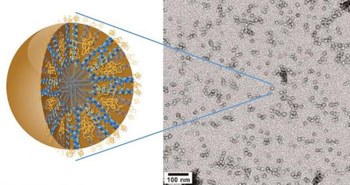Novel Nanocarriers Ferry Anticancer Drugs Across the Blood-Brain Barrier
By LabMedica International staff writers
Posted on 07 Dec 2015
A recent paper described the development of a novel class of highly stable, long-circulating three-helix micelles (3HM) capable of ferrying chemotherapeutic agents across the blood-brain barrier for the treatment of the deadly brain tumor glioblastoma multiforme (GMB).Posted on 07 Dec 2015
Investigators at The Lawrence Berkeley National Laboratory (Berkeley, CA, USA) have responded to the urgent need for the development of nanocarriers to treat GBM. They have synthesized highly stable, long-circulating three-helix micelles (3HM), based on a coiled-coil protein tertiary structure as an alternative to larger and less effective nanocarriers.

Image: At only about 20 nanometers in size and featuring a unique hierarchical structure, 3HM nanocarriers meet all the size and stability requirements for effectively delivering therapeutic drugs to brain cancer tumors (Photo courtesy of Dr. Ting Xu, Lawrence Berkeley National Laboratory).
The 3HM carriers were made by attaching two C18 alkyl chains at the peptide N-terminus with a (6)-amino-hexanoic acid linker inserted between the peptide and the alkyl tail to introduce amphiphilicity. Another PEG chain was attached to the peptide C-terminus to provide a stealth layer in a similar fashion to that of PEGylated liposomes. The resulting amphiphile was termed as “1coi-dC18-PEG2K.” The intermolecular interactions between peptides and the compression of PEG on the exterior of the helix bundle increased the activation energy barrier for subunit desorption and provided stability to the micelle. Upon forming micelles, peptide-PEG conjugates in the head group self-associated into a trimeric subunit. The PEG chains attached to the exterior of the helix bundle could be used to tailor the inter-ligand cluster distance.
Taking all the design criteria into consideration, it was highly desirable to generate micellar nanocarriers in the size range of 10–30 nanometers, which combined a long circulation half-life, effective tumor tissue penetration, minimal cargo leakage, and efficient subunit clearance.
Results of a study published in the October 5, 2015, online edition of the Journal of Controlled Release revealed that by employing the radioactive form of copper (64Cu) in combination with positron emission tomography (PET) and magnetic resonance imaging (MRI), it was possible to demonstrate that 3HM of approximately 20 nanometers could cross the blood brain barrier and accumulate inside GBM tumors in a rodent xenograph model at nearly double the concentration rate of larger liposome nanocarriers. Furthermore, the nanoparticle accumulation was shown to extend to the margins of the GBM xenograft. The 3HM nanocarriers were degraded and cleared after a circulation half-life of 29.5 hours with significantly reduced accumulation in the liver and spleen.
"Our 3HM nanocarriers show very good attributes for the treatment of brain cancers in terms of long circulation, deep tumor penetration, and low accumulation in off-target organs such as the liver and spleen," said senior author Dr. Ting Xu, associate professor of polymer science and engineering at The Lawrence Berkeley National Laboratory. "The fact that 3HM is able to cross the blood brain barrier of GBM-bearing rats and selectively accumulate within tumor tissue opens the possibility of treating GBM via intravenous drug administration rather than invasive measures. While there is still a lot to learn about why 3HM is able to do what it does, so far all the results have been very positive."
Related Links:
The Lawrence Berkeley National Laboratory




 assay.jpg)








